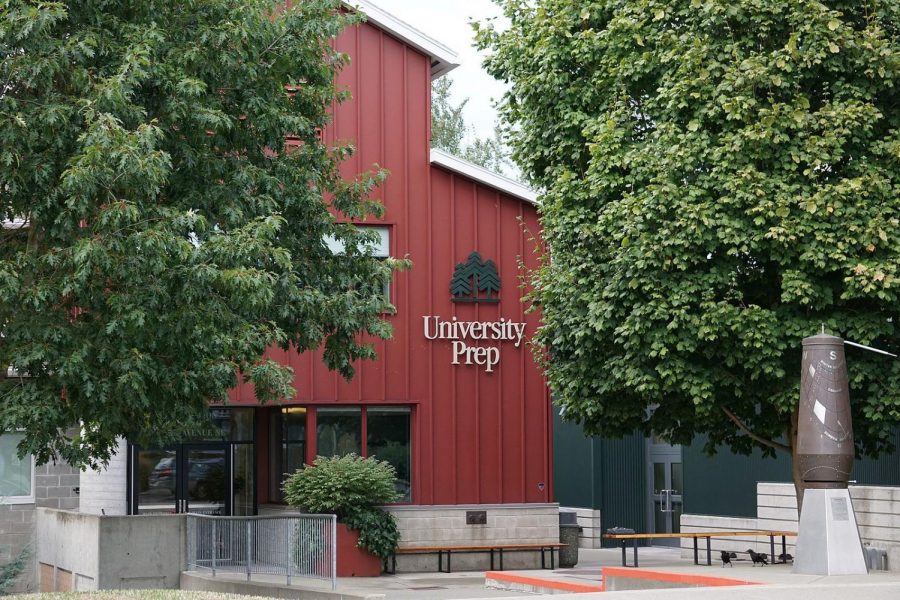Independent Schools Weigh Federal Recovery Loans
Private schools, including UPrep, consider small business relief programs
Photo: JSquish/Wikimedia Commons
Amid the pandemic, private schools across the country have considered Small Business Administration relief. UPrep decided against taking out a federal Paycheck Protection Program loan.
Anticipating greater financial aid need and lower consumer confidence, independent schools are not immune to growing financial burdens associated with the pandemic.
While federal lawmakers aim to keep small businesses and nonprofits afloat, some private institutions, including University Prep, have considered whether to take advantage of government-funded recovery programs.
As reported in the New York Times, New Jersey’s Pingry School — headed by former UPrep Head of School Matt Levinson — and Sidwell Friends, among other prep schools, have applied for federal Paycheck Protection Program loans. The schools maintain about $93 million and $50 million in their endowments, respectively, according to tax documents.
PPP loans deliver a “direct incentive for small businesses to keep their workers on the payroll,” in the form of funds up to $10 million, as stated in guidelines from the Small Business Administration. Through the PPP, the federal government may provide forgiveness “of up to the full principal amount of qualifying loans.”
Sidwell Friends, according to the Washington Post, received a $5.2 million loan. The Pingry School did not disclose the amount it borrowed.
In Seattle, representatives from UPrep, Seattle Academy, Eastside Prep and Lakeside School reported that their institutions did not apply for loans. The Bush School, at press time, had not decided whether it would apply for a loan.
According to Mark Crotty, executive director of the Northwest Association of Independent Schools, “some” of over 110 total member institutions have applied for loans. Crotty stated that he lacked knowledge of every member school’s choice and would not disclose which institutions had applied for loans.
Generally, nonprofit organizations, including independent schools like UPrep, are eligible for PPP loans. From the perspective of private schools, though, the level of need required to qualify for a loan remains largely ambiguous.
Both the National Association of Independent Schools and NWAIS informed member schools about the details outlining PPP loans without encouraging or discouraging applications for funds.
“The challenge is that there are really no guidelines about what ‘well-resourced’ means,” NAIS Vice President of Media Myra McGovern said. “It’s really hard for schools to gauge, and we’re encouraging them to consider their own financial situations, their assets and liabilities, really carefully.”
Assistant Head of School for Finance and Operations Susan Lansverk asserted that UPrep did not consider its needs great enough to qualify for a PPP loan. As reported in 2017 tax filings, UPrep’s endowment is nearly $11 million.
“Based on our review of the guidelines, we did not think we had the need for funds for ongoing operations that was required to receive the loan,” Lansverk said in an email.
Lansverk stated, however, that UPrep has not ruled out applying for federal assistance moving forward.
“Regarding seeking out relief in the future, it depends on the program,” Lansverk said. “For any program offered, we would review the application criteria and determine if we meet the requirements and are able to apply.”
In addition to including complicated application guidelines, PPP loans are also subject to federal requirements that can influence a school’s operations, meaning that schools receiving loans may not maintain total autonomy of their educational programs.
“Seattle Academy determined that the Federal Financial Assistance requirements that might be required for loan forgiveness might not align with the school’s emphasis on independently crafting its program for its students,” Doug Ambach, chief financial officer of SAAS, said in an email.
Crotty expanded on the interests of independent schools to maintain separation from federal mandates.
“We don’t want independent schools to do something that may strip them of some of their independence when it comes to things such as program hiring, governance [and] mission,” Crotty said. “The independence gives us so much of our strength.”
In addition, federal requirements surrounding academic programs can lead to new financial pressures on schools, including possible audits, depending on the amount borrowed.
“For some schools, particularly those that are small, the red tape or the administrative burdens are just seen as too complex or too much to manage without having to hire an entirely new person on staff,” McGovern said. “For some schools, that has been the deciding factor [when considering PPP loans].”
According to a 2017 NAIS survey of member schools, only 17% of responding institutions reported participating in any federal program. McGovern pointed to the unprecedented nature of current financial challenges.
“Very few independent schools participate in any federal programs, historically. This is a little bit different because this is such an extreme situation,” McGovern said.
While independent schools may face an extraordinary period of financial need, particularly wealthy institutions have not seen uniform support of their claimed eligibility for PPP funds.
Treasury Secretary Steven Mnuchin criticized applications of particularly wealthy independent schools for PPP loans in a May 1 tweet.
“It has come to our attention that some private schools with significant endowments have taken #PPP loans,” Mnuchin said in the tweet. “They should return them.”
Mnuchin’s tweet came after a flurry of headlines reporting the applications of PPP loans from several multimillion-dollar companies. Amid public pushback, Shake Shack and the Los Angeles Lakers returned $10 million and $4.6 million, respectively, from PPP loans.
As Northwest independent schools navigate increasingly challenging economic conditions, Crotty noted that “some schools have grappled with the ethical questions raised” by PPP loans.
McGovern, in response to Mnuchin, underlined the differences between characteristics of large businesses and the majority of independent schools. As she highlighted, the 1,600 NAIS member schools in the United States are nonprofits.
“They’re not money-making ventures. The majority are not very well-resourced. They’re also taking on this really important cause of educating students,” McGovern said.
Among NAIS member schools, the median endowment per student is about $20,000, with the median enrollment at 371 students, as reported in a 2019 survey from the group.
While the day-to-day operations of independent schools look distinct from those of the typical local small business, McGovern shared, the necessities underlying these institutions remain the same: to make payroll and keep doors open however possible.
“[Private schools] often struggle with many of the same issues that, say, a retail store or a restaurant might face in terms of cash flow,” McGovern said. “For a school that has a lot of resources, the PPP is probably not the right option for them. But for a school that has very few assets and is struggling to make payroll and considering furloughing workers or laying off workers, it’s a different picture.”
Despite his school’s reported endowment of over $90 million, Levinson described to the New York Times that leaders at Pingry “appreciate that [the PPP] will allow us to retain all our faculty and staff in a time of declining revenues, rising costs and great financial uncertainty.”
Locally, Crotty described the diversity of financial situations within the Northwest private school network.
“I sensed Secretary Mnuchin was referring to very well-resourced prep schools, especially those with large reserves and significant endowments. Not all NWAIS schools are in that financial position,” Crotty said.
Further, as McGovern articulated, an endowment of a private school is not merely a “big savings account.” Instead, the funds are often set up with designated purposes, like supporting financial aid need or professional development.
Looking ahead to an uncertain financial future, McGovern described the long-term considerations of private schools.
“Schools are really trying to evaluate what the impact of coronavirus and the impending recession will be,” McGovern said. “They’re … trying to calibrate their budget to see what the needs are and make sure they can take care of their faculty and staff.”


